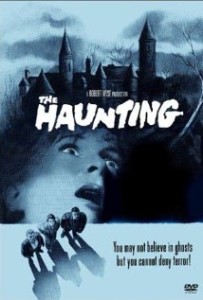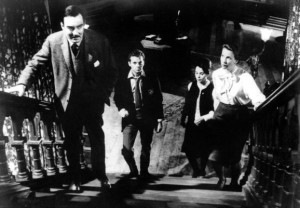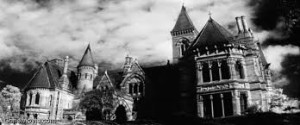“No live organism can continue for long to exist sanely under conditions of absolute reality; even larks and katydids are supposed, by some, to dream. Hill House, not sane, stood by itself against its hills, holding darkness within; it had stood for eighty years and might stand for eighty more. Within, walls continued upright, bricks met neatly, floors were firm, and doors were sensibly shut; silence lay steadily against the wood and stone of Hill House, and whatever walked there, walked alone.”
 Once upon a time in middle school, my friends ditched me on Halloween. It’s one of the those heartbreaking memories that you’re sure will haunt you forever, and it does… at least until the next moment of preteen drama usurps it from memory. For me, that new horror occurred a few hours later when my mom comforted me with a Turner Classic screening of The Haunting (1963), not to be confused with the unwatchable 1999 remake with Catherine Zeta Jones and Liam Neeson. Please don’t confuse them. The former is a technical wonder of an adaptation of Shirley Jackson’s The Haunting of Hill House, which had the power to scare the internal angst right out of my night with little more industry tricks of the trade than some nifty camera, light, and sound effects. The question is of course (the same we asked of Orson Well’s The War of The Worlds) after ten years since my first watching and over 50 since it was first released, is The Haunting still scary?
Once upon a time in middle school, my friends ditched me on Halloween. It’s one of the those heartbreaking memories that you’re sure will haunt you forever, and it does… at least until the next moment of preteen drama usurps it from memory. For me, that new horror occurred a few hours later when my mom comforted me with a Turner Classic screening of The Haunting (1963), not to be confused with the unwatchable 1999 remake with Catherine Zeta Jones and Liam Neeson. Please don’t confuse them. The former is a technical wonder of an adaptation of Shirley Jackson’s The Haunting of Hill House, which had the power to scare the internal angst right out of my night with little more industry tricks of the trade than some nifty camera, light, and sound effects. The question is of course (the same we asked of Orson Well’s The War of The Worlds) after ten years since my first watching and over 50 since it was first released, is The Haunting still scary?
The classic chills in “The Haunting” resonated with an only-child of a single working parent: like the creaking of an old house after midnight and the quiet click of a door popping open in an empty apartment. These tropes usually appear in the first quarter of almost every modern horror movie, before the simple terrors are abandoned for an escalating parade of usually bad computer effects and make up. The Haunting, however, sets itself a part from its filmic descendants in the genre in that it doesn’t rely on edge-of-your seat anticipation of the next shot of gore or a 10th jump scare. The Haunting promises and delivers on a constant pressure of an off scene presence that twists the audience as much as it does the characters.
Ah, the characters. After I’ve blathered on about practical and minimalistic effects for two paragraphs, you’d think that the technical methods of story-telling overshadowed the actors and the roles that they play. Not so in The Haunting. The major players are Dr. Markway, a professor with a more than passing interest in the supernatural, rents Hill House to conduct observations of psychic and supernatural phenomena, Luke Sanderson, playboy nephew of the owner of Hill House who is tasked with overseeing the research, and their guests: Theodora “Theo” and Eleanor “Nell” Lance. Both are contacted by Dr. Markway who, through his research, identified events of psychic phenomena in their pasts. The good doctor believes that the presence in the wicked old house will be stimulated by those gifted with a sixth sense.
Theo and Nell as performed by Claire Bloom and Julie Harris, respectively, are two of the most fascinating characters that I have ever seen in the horror genre. Nell was a caretaker for an overbearing mother until the old woman’s death; a life that has readied her for a fragile, inexperienced, and lonely adulthood. Nell excepts Markway’s invitation as her first move toward independence from the shared car and the living room she occupies in her married sister’s home. She has little experience with adults, though she has a more impressive record with the supernatural than any of the other members of the group. Theo, as a perfect foil to Nell, is beautiful, independent, and used to being the center of attention of both men and women, perhaps due to her charisma and extrasensory perception. She agrees to sit in on Markway’s observation at Hill House after separating from her girlfriend. Theo is one of the earliest representations of a explicit homosexuality in American cinema that does not depict a lesbian character as predatory or deviant. Ok, maybe explicit is giving the film too much credit, but you can read more about the character here and know this movie would be perfect for a paper assignment in a gender in film or feminist theory class.
As the talent in the house, the women are the targets nearly all the clearly malevolent taunting while the men, as the audience’s surrogates on screen, can do little more than observe Nell and Theo as both are terrorized by whatever forces lurk in the dark. While Nell seemingly flourishes as an object of attention for the first time, Theo preys upon the woman’s insecurity and fragility in order to push Nell away. Like fast-made friends on the first day of school, their blossoming friendship of one night turns morphs into catty hostility over the course of their stay. If only 12 year-old me had been able to draw this out of the narrative, I could have felt far better about one shitty Halloween night.
Beyond the deteriorating relationship of Nell and Theo, the reason The Haunting is a perfect psychological supernatural story is that its characters are all symbols of how people experience horror. The skeptic young heir sees every creepy statue as pieces of art that he can hock to get his money’s worth out of the old house and is therefore rarely frightened. The doctor is fascinated by a harp that issues beautiful music without a player, but it neither terrifies or unsettles him. Both Nell and Theo came to Hill House with heightened psychic perceptions, but it is only fragile Nell that is driven to insanity after a life of neglect and loneliness. Whether entering a spooky graveyard, a ghostly mansion, or a dark movie theater, hants can do little more than rattle a chain or let out a ghoulish moan. There is terror only in what you bring with you.
Shirley Jackson is an icon, not only as a woman author in horror as legendary as Mary Shelley, but as the creator of many of your favorite horror tropes. Stephen King has cited her as a major influence in all his writing, which can be seen in Carrie and Rose Red, and I encourage everyone to check her out her work
Kaitlyn D
Senior Staff Writer
@deadrabbit92
















